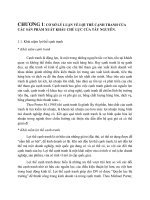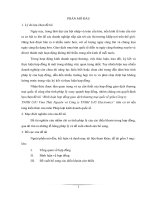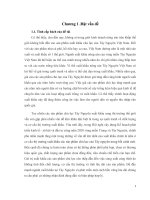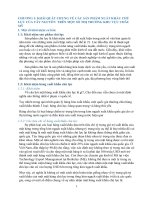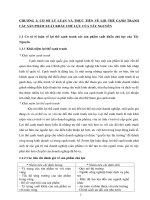giao dich thuong mai quoc te nguyen hoang anh chuan bi dam phan ki ket hop dong cuuduongthancong com
Bạn đang xem bản rút gọn của tài liệu. Xem và tải ngay bản đầy đủ của tài liệu tại đây (525.57 KB, 51 trang )
Chuẩn bị đàm phán ký kết hợp đồng
Nghiên cứu hàng hoá
. Tính chất, qui cách phẩm chất, công dụng
. Yêu cầu của thị tr-ờng về mặt hàng
. Tìm hiểu tình hình sản xuất và kinh doanh
. Chu kỳ sống của sản phẩm
. Tỷ suất ngoại tệ
CuuDuongThanCong.com
/>
Nghiên cứu thị tr-ờng
Dung l-ợng thị tr-ờng
Tình hình thị tr-ờng
CuuDuongThanCong.com
/>
Nghiên cứu th-ơng nhân
T- cách pháp lý của th-ơng nhân
Ngành nghề
Khả năng tài chính
Khả năng thanh toán
Cơ sở vật chất
Thái ®é
Uy tÝn
CuuDuongThanCong.com
/>
Lập ph-ơng án kinh doanh
Đánh giá tính hình thị tr-ờng và th-ơng nhân
Đề ra các mục tiêu
Biện pháp thực hiện
Đánh giá sơ bộ hiệu quả kinh tế:
Tỷ suất ngoại tệ, lợi nhuận, thời gian hoàn
vốn, điểm hoà vốn..
CuuDuongThanCong.com
/>
Đặt hàng
P là chi phí đặt mua mỗi đơn hàng
Q là trị giá mỗi đơn hàng
d là chi phí mua vào
A là nhu cầu hàng năm
S là chi phí l-u kho bình quân cả năm
Chi phí đặt hàng là
CuuDuongThanCong.com
/>
C«ng thøc EOQ
d = PA/Q + SQ/2
d’ = - PA/Q + S/2 = 0
Q2
=
2AP/S
VËy
Q
=
√2AP/S
CuuDuongThanCong.com
/>
Qui dẫn giá
Qui dẫn về một đồng tiền chung
Qui dẫn về cùng một đơn vị đo l-ờng
Qui dẫn về cùng một điều kiện cơ sở giao hàng
Qui dẫn về cùng một đơn vị thời gian:P0/I0 = P1/I1, ta
có P1 = I1. P0/I0
Qui dÉn vỊ cïng mét ®iỊu kiƯn tÝn dơng:
T = XiTi
Xi
CuuDuongThanCong.com
/>
Qui dÉn tõ gi¸ CIF vỊ gi¸ FOB
FOB = CIF – I – F
= CIF –R(CIF + pCIF) – F
= CIF – RCIF(1 + p) - F
CuuDuongThanCong.com
/>
Qui dÉn tõ gi¸ FOB vỊ gi¸ CIF
CIF = C + I + F
CIF = C + RCIF(1 + p) + F
CIF – RCIF(1+ p) = C + F
CIF = C + F/1-R(1+p)
NÕu p = 0 th× CIF = C + F
1- R
NÕu p = 1 th× CIF = C + F
1 - 1,1 R
CuuDuongThanCong.com
/>
Bài tập 1
Một doanh nghiệp nhận một đơn chào bán
vói giá 2000USD cho một chiếc xe máy.
Đơn chào đ-a ra các điều kiện sau:
Trả 80% một tháng sau khi giao hàng
Trả 20% hai tháng sau khi giao hàng
Nếu doanh nghiệp mua với điều kiện trả
ngay thì giá là bao nhiêu biết lÃi suất là
8%/năm
CuuDuongThanCong.com
/>
Đàm phán th-ơng mại
trade negotiation
What is negotiation?
An interactive communication process that
may take place whenever you want something
from somebody else or they want something
from you.
OH, KWAN-CHI
POSCO RESEARCH INSTITUTE
CuuDuongThanCong.com
/>
Roger fisher & william ury
Đàm phán là ph-ơng tiện cơ bản để đạt
đ-ợc cái ta mong muốn từ ng-ời khác.
Đó là quá trình giao tiếp có đi có lại,
đ-ợc thiết kế nhằm đạt thoả thuận trong
khi giữa ta và đối tác có những quyền lợi
có thể chia sẻ và những quyền lợi đối
kháng
CuuDuongThanCong.com
/>
đàm phán là gì
Đàm phán là quá trình trao đổi ý kiến giữa các bên
có lợi ích chung và lợi ích xung đột để tìm ra các
giải pháp điều hoà các xung đột và phát triển các
lợi ích chung
Đàm phán th-ơng mại là quá trình trao đổi ý kiến
giữa bên mua và bên bán về các vấn đề liên quan
đến giao dịch mua bán nhằm đạt đ-ợc sự nhất trí
để ký kết hợp đồng th-ơng mại
CuuDuongThanCong.com
/>
When to Use Negotiation:
Khi nào thì đàm phán
When Competitive Bidding is
Impractical or Inappropriate
When Risks and Costs cannot be
accurately predetermined
When the buyer is contracting for a
portion of the seller’s production
capacity
CuuDuongThanCong.com
/>
Objectives of Negotiations
To obtain the quality specified
To obtain a fair and reasonable price
To get the supplier to perform the contract on time
To exert some control over manor in which the
contract is carried out
To achieve maximum cooperation
To maintain relationships
To create a long-term relationship
CuuDuongThanCong.com
/>
NEGOTIATION strategies
Soft
Hard
Principled
decide issues on their merits rather than
through haggling
CuuDuongThanCong.com
/>
THE OLD BOOK ON NEGOTIATION
• “Win -Win” Negotiations: The Good Ones
•
“Win-Lose” Negotiations: The Bad Ones
•
“Lose-Lose” Negotiations: The Tragedies
THE NEW BOOK ON NEGOTIATION
• Everyone negotiates for one and only one reason:
to achieve their goals.
•
No one ever does anything that is against their interests
(at least as they perceive those interests).
CuuDuongThanCong.com
/>
The Four Stages Of Negotiation
Preparation
Exchanging
Information
Opening and
Concession Making
(Bargaining)
Closing and
Commitment
CuuDuongThanCong.com
/>
Preparation
Know the item or service
Know the seller’s bargaining strength
Know the buyer’s bargaining strength
cost or price analysis
Know the seller
CuuDuongThanCong.com
/>
Aspects to Negotiate
Price
Quality
Support
Supply
Transportation
Duration
CuuDuongThanCong.com
/>
The Six Foundations of Effective
Negotiation
Attitude to Conflict
I
Bargaining Style
Fear of Loss
Power of Expectation
II
Goals
VI
Leverage
InformationBased
bargaining
V
Their Interests
IV
Relationships
Self-Esteem
and Self-Interest
III
Authoritative
Standards
Reciprocity Norm
CuuDuongThanCong.com
/>
Your Bargaining Style:Checklist
Determine your basic style preferences.
Acquire a willingness to prepare.
Set high expectations.
Have the patience to listen.
Make a commitment to personal integrity.
CuuDuongThanCong.com
/>
The Relationship Factor: A Checklist
Gain access and credibility through relationship networks.
Build working relationships across the table with small
steps
such as gifts, favors, disclosures, or concessions.
Avoid reciprocity and relationship traps like trusting too
quickly, letting others make you feel guilty, and mixing big
business with personal friendships.
Always follow the “Rule of Reciprocity”:
• Be reliable and trustworthy.
• Be fair to those who are fair to you.
• When other parties treat you unfairly, let them know about
CuuDuongThanCong.com
/>
EXPLORING THE OTHER PARTY’S
INTERESTS: A Checklist
Locate the decision maker.
How might it serve the other party’s interests to help
you achieve your goals?
Why might the other party say “no”?
What low cost options might remove the other party’s
objections?
CuuDuongThanCong.com
/>
A Leverage Checklist
Which side has the most to lose from no deal?
For whom is a time a factor?
Can I improve my alternatives or make the other party’s
worse?
Can I gain control over something the other party needs?
Can I commit the other party to norms that favor my result?
Can I form a coalition to improve my position?
CuuDuongThanCong.com
/>




